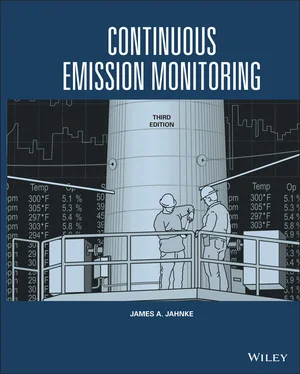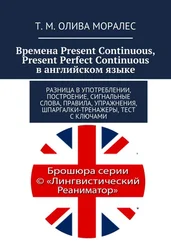James A. Jahnke - Continuous Emission Monitoring
Здесь есть возможность читать онлайн «James A. Jahnke - Continuous Emission Monitoring» — ознакомительный отрывок электронной книги совершенно бесплатно, а после прочтения отрывка купить полную версию. В некоторых случаях можно слушать аудио, скачать через торрент в формате fb2 и присутствует краткое содержание. Жанр: unrecognised, на английском языке. Описание произведения, (предисловие) а так же отзывы посетителей доступны на портале библиотеки ЛибКат.
- Название:Continuous Emission Monitoring
- Автор:
- Жанр:
- Год:неизвестен
- ISBN:нет данных
- Рейтинг книги:4 / 5. Голосов: 1
-
Избранное:Добавить в избранное
- Отзывы:
-
Ваша оценка:
- 80
- 1
- 2
- 3
- 4
- 5
Continuous Emission Monitoring: краткое содержание, описание и аннотация
Предлагаем к чтению аннотацию, описание, краткое содержание или предисловие (зависит от того, что написал сам автор книги «Continuous Emission Monitoring»). Если вы не нашли необходимую информацию о книге — напишите в комментариях, мы постараемся отыскать её.
The new edition of the only single-volume reference on both the regulatory and technical aspects of U.S. and international continuous emission monitoring (CEM) systems Continuous Emission Monitoring
Continuous Emission Monitoring:
Continuous Emission Monitoring, Third Edition
Continuous Emission Monitoring — читать онлайн ознакомительный отрывок
Ниже представлен текст книги, разбитый по страницам. Система сохранения места последней прочитанной страницы, позволяет с удобством читать онлайн бесплатно книгу «Continuous Emission Monitoring», без необходимости каждый раз заново искать на чём Вы остановились. Поставьте закладку, и сможете в любой момент перейти на страницу, на которой закончили чтение.
Интервал:
Закладка:
In‐situ analyzers are used to measure the concentrations of pollutant and combustion gases and particulate matter, flue gas opacity, and flue gas velocity (flow). Both point and path techniques are used to monitor gas and particulate concentrations. Opacity monitors (transmissometers) are path monitors and can be either single‐pass or double‐pass systems, measuring the transmittance of visible light through the stack. Flow monitors are designed in either point or path configurations, depending upon the analytical technique.
Using wavelength‐tunable lasers, in‐situ gas monitoring systems are experiencing renewed popularity, particularly for the measurement of reactive gases such as HCl and NH 3. More attention is being paid to verifying system calibration using NIST traceable calibration gases, an important issue in the United States. In‐situ point monitors using laser‐light scattering techniques have become popular for monitoring flue gas particulate matter concentrations. Light‐scattering particle sizing techniques are developing, but this technology has lagged behind in source monitoring applications for many years.
Remote Sensors
Remote sensing systems have no interface between the stack gases and the sensing instrument, other than the ambient atmosphere. They thus avoid problems associated with a stack or duct interface. These systems can detect emission concentrations merely by projecting light up to the stack (active systems) or by sensing the light radiating from the “hot” molecules emitted from the stack (passive systems). However, due to an inherent problem in defining the length of the measurement path in the plume, the accuracy of gas concentration data is poorer than that obtained by the extractive or in‐situ techniques. This problem is also an issue in making flue gas measurements using laser systems mounted on unmanned aerial vehicles (drones), a developing source monitoring technology.
The U.S. EPA has developed Method 9A for monitoring stack exit opacity, using a laser light detection and ranging technique (LIDAR). The method is particularly useful at night or under atmospheric conditions that are not favorable to a visible emissions observer (VEO) performing EPA test method 9. In a related development, a digital camera technique for measuring plume opacity has been standardized by ASTM in ASTM standard D7520‐16. Although not a continuous method, data using this method are being accepted by regulatory agencies for visible emissions compliance determinations.
Test methods and certification procedures have not been standardized for remote sensing systems used to monitor gaseous emissions. Since the regulatory applicability of remote pollutant gas measurements to stationary sources has not yet been established, these systems for source emissions monitoring are not extensively applied in commercial applications. They have, however, seen wider application in “fence‐line” monitoring, particularly at petroleum refineries and chemical plants. Attempts are frequently made to correlate emissions data with long‐path remote sensing data obtained along a plant perimeter. Such correlations typically devolve into research studies and have met with limited success as a regulatory tool.
Unmanned aerial vehicles (UAVs) (drones) offer significant potential in source monitoring applications (Villa et al. 2016). UAV systems can obtain grab sample for laboratory analysis, or, as part of an active remote system, incorporate a stationary mirror to reflect light projected from a ground‐based analyzer. Using lasers, two drones standing‐off from a stack exit can make cross‐stack gas measurements. Four drones could measure on two diameters. UAV platforms can carry simple miniature sensors, readily available from hand‐held monitors, to measure flue gases in real time using a stand‐off probe or by flying through the stack. For compliance measurements, a probe can be inserted from the UAV “down” the stack, as it hovers at a fixed position next to the stack. The availability, at present, of miniature and micro analyzers provides many options for analysis using UAV platforms. Flares and smaller process stacks with limited access or without sampling platforms are seen as potential applications for this technology.
Performance specification and certification procedures have not been developed for remote sensing systems or UAVs; however, this technology is relatively new. Calibration procedures and precision and accuracy issues relative to in‐stack measurements must first be standardized for UAV data to be credible. Standards developed by independent standards bodies such as ASTM or ISO may provide a basis for future agency requirements. Because the regulatory applicability of remote and UAV pollutant gas measurements to stationary sources has not yet been established, they will not be discussed further, but do bear watching in the technical literature.
Parameter Monitoring Systems
Alternative approaches to emissions monitoring have been developed that do not require the use of analytical instrumentation, but rely instead on inputs from process sensors, such as thermocouples, pressure transducers, and fuel flow meters. Data from these sensors can be used in a variety of ways in environmental regulatory programs. The parameter information can be either used directly as a surrogate to substitute for concentration‐based emissions data or it can be incorporated into a model to predict emissions.
U.S. regulatory programs have long used parameter data such as pressure drop or temperature to monitor the performance of emission control equipment. The parameter data has been used either as a regulatory trigger to initiate enforcement action directly or as an indicator of noncompliance with permit conditions. Control equipment and unit operational parameters can also be used directly in continuous parameter monitoring systems (CPMS) as part of a continuous monitoring system (CMS). This regulatory approach does not require the use of continuous emission monitoring systems although a CEM system can be a part of a CMS. The U.S. air toxics standards make extensive use of this method.
A more recent approach has been used to develop emission models based on process parameter data. Models are developed by first correlating parameter data to emissions data. An initial study is performed by varying and monitoring process and control equipment parameters while monitoring flue gas emissions using reference methods or CEM systems. One can then correlate the data using engineering calculations, least squares methods, or neural net techniques to develop a model that “predicts” emissions from parameter data. Such predictive emission monitoring systems (PEMS) employ from 3 to 20 input parameters and have been applied to a variety of sources. They are most successful on sources with minimal variation in fuels and operating conditions.
Analytical Techniques Used in CEM System Instrumentation
The analytical techniques used in extractive and in‐situ CEM systems encompass a wide range of chemical and physical methods. These vary from chemical methods using simple electrochemical cells to advanced electro‐optical techniques such as wavelength modulation and Fourier‐transform infrared spectroscopy. Table 1‐1summarizes the analytical techniques that are used in currently marketed CEM systems for gases. Table 1‐2gives a summary of analytical techniques used in continuous emission monitoring systems for particulate matter (PM CEMS).
Techniques used for laboratory analysis, as well as techniques applied specifically for emissions monitoring, have been incorporated into commercially marketed systems. New analyzers have been developed using established electro‐optical methods, but are beginning to incorporate new light sources and detectors, such as tunable diode lasers, quantum cascade lasers, and diode arrays and new techniques such as cavity ringdown spectroscopy. The incorporation of microprocessors into today's analyzers has added useful features such as data storage, troubleshooting diagnostics, and external communication.
Читать дальшеИнтервал:
Закладка:
Похожие книги на «Continuous Emission Monitoring»
Представляем Вашему вниманию похожие книги на «Continuous Emission Monitoring» списком для выбора. Мы отобрали схожую по названию и смыслу литературу в надежде предоставить читателям больше вариантов отыскать новые, интересные, ещё непрочитанные произведения.
Обсуждение, отзывы о книге «Continuous Emission Monitoring» и просто собственные мнения читателей. Оставьте ваши комментарии, напишите, что Вы думаете о произведении, его смысле или главных героях. Укажите что конкретно понравилось, а что нет, и почему Вы так считаете.












